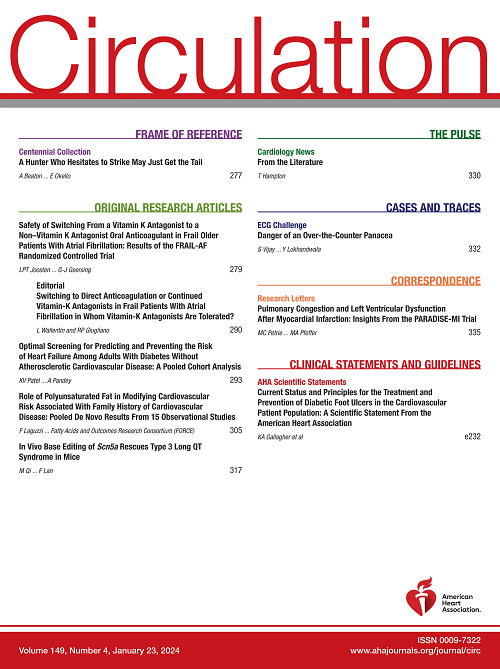Conduction Disturbances and Outcome After Surgical Aortic Valve Replacement in Patients With Bicuspid and Tricuspid Aortic Stenosis.
IF 38.6
1区 医学
Q1 CARDIAC & CARDIOVASCULAR SYSTEMS
引用次数: 0
Abstract
BACKGROUND This study aimed to compare the incidence and prognostic implications of new-onset conduction disturbances after surgical aortic valve replacement (SAVR) in patients with bicuspid aortic valve (BAV) aortic stenosis (AS) versus patients with tricuspid aortic valve (TAV) AS (ie, BAV-AS and TAV-AS, respectively). Additionally, the study included stratification of BAV patients according to subtype. METHODS In this cohort study, the incidence of postoperative third-degree atrioventricular (AV) block with subsequent permanent pacemaker requirement and new-onset left bundle-branch block (LBBB) was investigated in 1147 consecutive patients without preoperative conduction disorder who underwent isolated SAVR (with or without ascending aortic surgery) between January 1, 2005, and December 31, 2022. The groups were stratified by aortic valve morphology (BAV, n=589; TAV, n=558). The outcomes of interests were new-onset third-degree AV block or new-onset LBBB during the index hospitalization. The impact of new-onset postoperative conduction disturbances on survival was investigated in BAV-AS and TAV-AS patients during a median follow-up of 8.2 years. BAV morphology was further categorized according to the Sievers and Schmidtke classification system (possible in 307 BAV-AS patients) to explore association between BAV subtypes and new-onset conduction disturbances after SAVR. RESULTS The overall incidence of third-degree AV block and new-onset LBBB after SAVR was 4.5% and 7.8%, respectively. BAV-AS patients had a higher incidence of both new-onset third-degree AV block (6.5% versus 2.5%; P=0.001) and new-onset LBBB (9.7% versus 5.7%; P=0.013) compared with TAV-AS patients. New-onset LBBB was associated with an increased all-cause mortality during follow-up (adjusted hazard ratio, 1.60 [95% CI, 1.12-2.30]; P=0.011), whereas new-onset third-degree AV block was not associated with worse prognosis. Subgroup analysis of the BAV cohort revealed that BAV-AS patients with fusion of the right- and non-coronary cusps had the highest risk of new-onset third-degree AV block (adjusted odds ratio [aOR], 8.33 [95% CI, 3.31-20.97]; P<0.001, with TAV as reference group) and new-onset LBBB (aOR, 4.03 [95% CI, 1.84-8.82]; P<0.001, with TAV as reference group), whereas no significant association was observed for the other BAV subtypes. CONCLUSIONS New-onset LBBB after SAVR is associated with increased all-cause mortality during follow-up, and is more frequent complication in BAV AS patients compared with TAV-AS patients. BAV-AS patients with fusion of the right- and non-coronary cusps have an increased risk for conduction disturbances after SAVR. This should be taken into consideration when managing these patients.二尖瓣和三尖瓣主动脉瓣狭窄患者手术主动脉瓣置换术后的传导障碍和预后。
背景本研究旨在比较双尖瓣主动脉瓣狭窄(BAV)患者与三尖瓣主动脉瓣狭窄(TAV)患者(即分别为 BAV-AS 和 TAV-AS)在主动脉瓣置换术(SAVR)后新发传导障碍的发生率和预后影响。在这项队列研究中,研究人员调查了 2005 年 1 月 1 日至 2022 年 12 月 31 日期间接受孤立 SAVR(无论是否进行升主动脉手术)的 1147 名连续患者术前无传导障碍,术后出现三度房室(AV)传导阻滞并随后需要永久起搏器和新发左束支传导阻滞(LBBB)的发生率。各组按主动脉瓣形态分层(BAV,589 人;TAV,558 人)。关注的结果是在指数住院期间新发的三度房室传导阻滞或新发的 LBBB。在中位随访 8.2 年期间,研究人员调查了 BAV-AS 和 TAV-AS 患者术后新发传导障碍对存活率的影响。结果SAVR术后三度房室传导阻滞和新发LBBB的总发生率分别为4.5%和7.8%。与TAV-AS患者相比,BAV-AS患者新发三度房室传导阻滞(6.5%对2.5%;P=0.001)和新发LBBB(9.7%对5.7%;P=0.013)的发生率更高。新发 LBBB 与随访期间全因死亡率增加有关(调整后危险比为 1.60 [95% CI, 1.12-2.30];P=0.011),而新发三度房室传导阻滞与预后恶化无关。BAV 队列的亚组分析显示,右心尖和非心尖融合的 BAV-AS 患者发生新发三度房室传导阻滞的风险最高(调整后比值比 [aOR],8.33 [95% CI,3.31-20.97];P<0.001,以 TAV 为参照组),新发 LBBB 的风险也最高(aOR,4.03 [95% CI,1.84-8.82];P<0.001,以 TAV 为参照组)。结论SAVR术后新发LBBB与随访期间全因死亡率增加有关,与TAV-AS患者相比,LBBB是BAV AS患者更常见的并发症。右心尖和非心尖融合的 BAV-AS 患者在 SAVR 术后出现传导障碍的风险更高。在管理这些患者时应考虑到这一点。
本文章由计算机程序翻译,如有差异,请以英文原文为准。
求助全文
约1分钟内获得全文
求助全文
来源期刊

Circulation
医学-外周血管病
CiteScore
45.70
自引率
2.10%
发文量
1473
审稿时长
2 months
期刊介绍:
Circulation is a platform that publishes a diverse range of content related to cardiovascular health and disease. This includes original research manuscripts, review articles, and other contributions spanning observational studies, clinical trials, epidemiology, health services, outcomes studies, and advancements in basic and translational research. The journal serves as a vital resource for professionals and researchers in the field of cardiovascular health, providing a comprehensive platform for disseminating knowledge and fostering advancements in the understanding and management of cardiovascular issues.
 求助内容:
求助内容: 应助结果提醒方式:
应助结果提醒方式:


